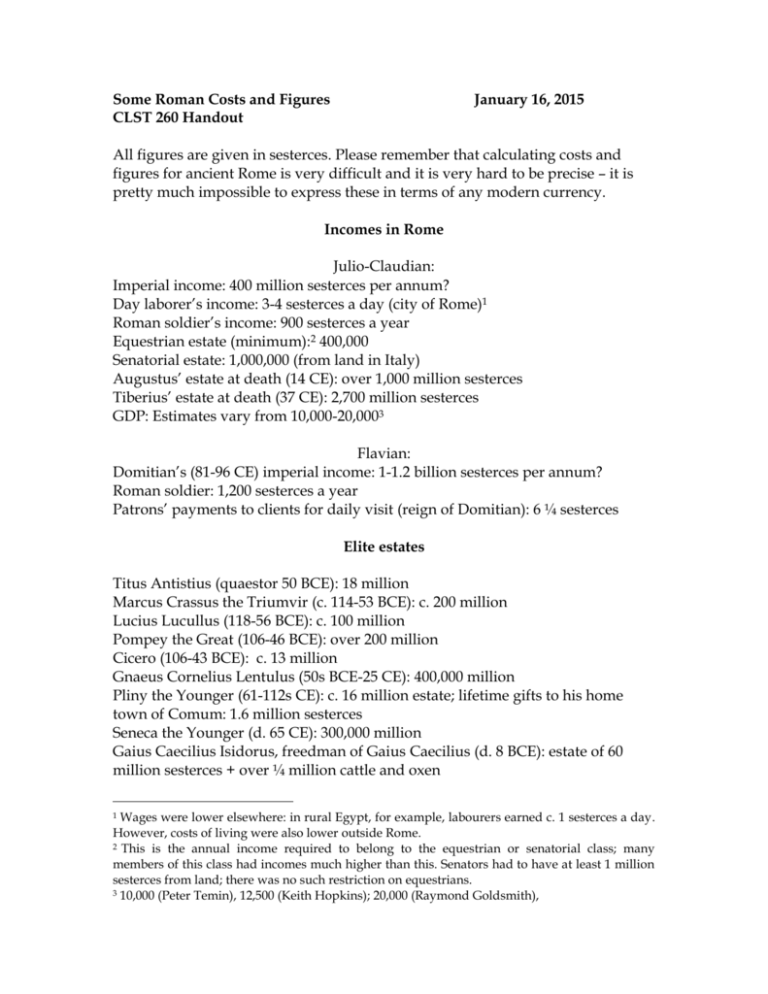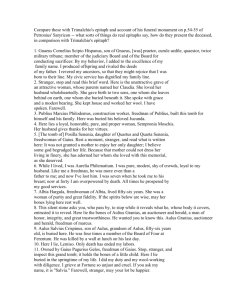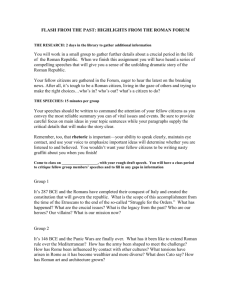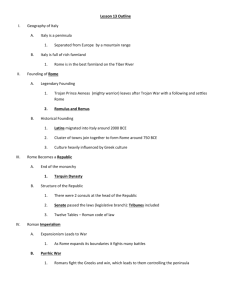Roman prices and costs of living
advertisement

Some Roman Costs and Figures CLST 260 Handout January 16, 2015 All figures are given in sesterces. Please remember that calculating costs and figures for ancient Rome is very difficult and it is very hard to be precise – it is pretty much impossible to express these in terms of any modern currency. Incomes in Rome Julio-Claudian: Imperial income: 400 million sesterces per annum? Day laborer’s income: 3-4 sesterces a day (city of Rome)1 Roman soldier’s income: 900 sesterces a year Equestrian estate (minimum):2 400,000 Senatorial estate: 1,000,000 (from land in Italy) Augustus’ estate at death (14 CE): over 1,000 million sesterces Tiberius’ estate at death (37 CE): 2,700 million sesterces GDP: Estimates vary from 10,000-20,0003 Flavian: Domitian’s (81-96 CE) imperial income: 1-1.2 billion sesterces per annum? Roman soldier: 1,200 sesterces a year Patrons’ payments to clients for daily visit (reign of Domitian): 6 ¼ sesterces Elite estates Titus Antistius (quaestor 50 BCE): 18 million Marcus Crassus the Triumvir (c. 114-53 BCE): c. 200 million Lucius Lucullus (118-56 BCE): c. 100 million Pompey the Great (106-46 BCE): over 200 million Cicero (106-43 BCE): c. 13 million Gnaeus Cornelius Lentulus (50s BCE-25 CE): 400,000 million Pliny the Younger (61-112s CE): c. 16 million estate; lifetime gifts to his home town of Comum: 1.6 million sesterces Seneca the Younger (d. 65 CE): 300,000 million Gaius Caecilius Isidorus, freedman of Gaius Caecilius (d. 8 BCE): estate of 60 million sesterces + over ¼ million cattle and oxen Wages were lower elsewhere: in rural Egypt, for example, labourers earned c. 1 sesterces a day. However, costs of living were also lower outside Rome. 2 This is the annual income required to belong to the equestrian or senatorial class; many members of this class had incomes much higher than this. Senators had to have at least 1 million sesterces from land; there was no such restriction on equestrians. 3 10,000 (Peter Temin), 12,500 (Keith Hopkins); 20,000 (Raymond Goldsmith), 1 Narcissus, freedman of the Emperor Claudius (d.54 BCE): estate of 400,000 million Costs of gladiators: c. 1 CE Tiberius paid 100,000 sesterces to retired gladiators to bring them out of retirement Figures restricting costs of gladiators from the Senatus Consultum de pretiis gladiatorum minuendis (177 CE)4: Assiforana:5 total cost can be no more than 30,000 sesterces Public munera Games costing total 30,000-60,000 3,000; 4,000; 5,000 per gladiator Games costing 60,000-100,000 5,000; 6,000; 8,000 per gladiator Games costing 100,000-150,000 5,000; 6,000; 7,000; 10,000; 12,000 per gladiator Games costing more than 150,000 6,000; 7,000; 10,000; 12,000; 15,000 Gladiators from the herd: 2,000-1,000 sesterces (at least 50% Criminals for execution: 600 sesterces Other Athletic incomes/costs: Charioteers: Diocles (122-c.140s ce): 36 million sesterces over career Gutta (2nd century CE): 2,150,000 sesterces over career6 Eutychus (reign of Caligula): 2 million sesterces in gifts from Caligula Mimes: Unknown, but high, especially for superstars: for a mime to buy his freedom was 700,000 sesterces or so, showing the level of profit they would bring their owner. Beyond this it is hard to be sure: Known costs of some munera, venationes, and ludi: In addition to the cost of hiring gladiators there was also a government tax ranging from 25-33% of the total cost. 5 Games given to make a profit, with prices charged for admission. 6 As his inscription (CIL 6.10047) only lists major prizes, he presumably won far more over his career. 4 North Africa: Carthage: 200,000 for gladiators and venationes for 4 days (133/8 CE) Smirat: four panthers killed for a total cost of 16,000 sesterces (mid 200s CE) Gor: 240 sesterces for a boxing display Italy: Rome: Costs allocated to aediles to hold various games:7 Ludi Romani: 200,000 (until 213 BCE); 333,333 (212-?)8; 760,00 (51 CE) Ludi Plebii 600,000 (51 CE) Ludi Apollinares: 20,000 (179 BCE); 380,000 (51 CE) Other figures from Rome: 186 BCE: M. Fulvius Noblilior (Aetolian War): 10 days of ludi: including a hunt with lions and leopards = 80,000 sesterces c.160 BCE Polybius says 750,000 sesterces costs for a lavish gladiatorial show. 60-50s BCE Milo’s three fortunes: Cicero reports that Milo spent either 1 million sesterces or 10 million on one set of games. Caligula: gift of 2 million sesterces to charioteer Hadrian: receives 4 million sesterces from Emperor Trajan in 106 and 107 CE to celebrate his election as praetor Outside Rome: Pisaurum, N. Italy 150,000 (after 100 CE) Aeclanum, S. Italy: 200,000 (?) (161/9? CE) Other prices and figures in ancient Rome: Rent: a. house on the Palatine rented by Marcus Caelius Rufus for 30,000 sesterces in 50s BCE pa b. Cicero income from two insulae on Argiletum and the Aventine Hills in Rome in 50 BCE: 80-100,000 sesterces c. Cost for house of Scaurus on the Palatine purchased by Clodius in 53 BCE: 14,800,000 Entertainment: Feasts for public (imperial period): 2-30 sesterces per head, Italy Sportula:9 4-20 sesterces per head, Italy. (The average person normally received about 4 sesterces.) Extra amounts could be accessed by using the fines the aediles levied for the games and by the aediles demanding goods, etc. from Italy and the provinces. 8 Presumably it went up before 51 CE, but we have no idea when or by how much. 9 Small gifts made from patrons to clients, from emperors to the people, and so forth. These were often distributed at games. 7 Wine: 2-4 sesterces an amphora for cheap wine. These varied in size, but usually contained c.26 litres. Wheat: highly variable from 1-20 sesterces per modius10 depending on the harvest; basic price is 2-4 sesterces per modius. Papyrus 2-4 sesterces per roll. There are 20 sheets in an average roll. Animals: Bears: the highest price we hear of is 1,000 per bear11 For transit costs see Stanford Orbis (http://orbis.stanford.edu/) Diocletian’s Edict of Maximum Prices (301 CE) African lion: 600,000 (first class) African lioness: 400,000 (second class) Bibliography If Roman economics have caught your interest the following are excellent places to start: Scheidel, Walter and Stephen J. Freisen 2009. “The size of the economy and the distribution of income in the Roman Empire.” Princeton/Stanford Working Papers in Classics Duncan-Jones, Richard. 1982. The Economy of the Roman Empire. Cambridge. Temin, Peter. 2013. The Roman Market Economy. Princeton, NJ. (Review: http://blogs.lse.ac.uk/lsereviewofbooks/2013/05/17/book-reviewthe-roman-market-economy/) A modius is about 9 litres (16 pints). 5 modii per month seems to have been the ration for members of the plebs; this equals about 3,000-3,500 calories per day. 11 That, however, is in a 2nd century CE novel, The Golden Ass, and the individual is basically being extorted at the time: all of his bears had died and he really needed some for a show. 10








